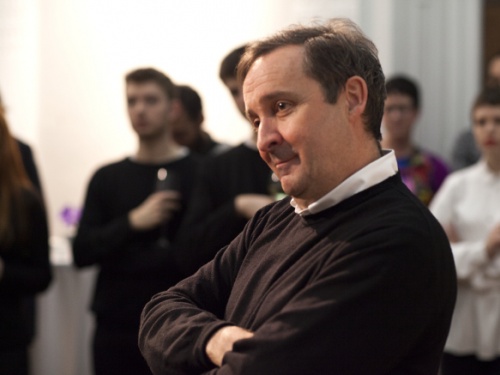Remote Control
Throughout the exhibition Remote Control, the ICA's Lower Gallery is temporarily reconstructed as a symbolic archive of material - both audio-visual and physical - that looks at mapping the structure of information dissemination and offers a possible prehistory to the networked environment of today. Within this newly commissioned installation designed by Berlin-based artist Simon Denny, the artist has brought together a matrix of ideas surrounding alternative approaches to media, spatial distribution and ecology, as well as conceived a platform for displaying a selection of video works from the past 40 years.
The diverse selection of historical material featured here is by no means comprehensive, but provides an unequivocal indication of the breadth of artistic responses to the phenomenon of television. Many of the works assert themselves within the well-established critique of mass media, taking an emphatically irreverent stance vis-à-vis the ideological imperatives imposed by official broadcast circuits. Exemplary of such works are Richard Serra’s acutely critical Television Delivers People, and Ant Farm’s polemical piece Media Burn. Others within the selection of works make a case for the television intervention as an unmediated art form in its own right. Works such as David Hall’s TV Interruptions, and those produced under the rubric of Gerry Schum’s Fernsehgalerie (TV Gallery) project, are nothing short of a testament to the potential of television as an experimental medium. These works, together with others by artists such as Dara Birnbaum and Dan Graham, KRIWET, and Marcel Odenbach, are shown on a bank of brand new cathode ray tube (CRT) television monitors imported from China.
While looking back at the history of artistic engagement with television, the installation simultaneously contemplates the uncertain future of a technology on the verge of obsolescence. Looming over the central space of the gallery are the relics of analogue broadcasting hardware, previously used to transmit the ever-popular UK Channel 4 station to parts of East Anglia. Given the impending switchover from analogue to digital transmission in the UK (which takes effect the week of Remote Control’s opening), this profusion of antiquated equipment begs consideration of a number of salient questions: What might become of the legacy of analogue technology in the digital age? What are the implications and social costs of our persistent urge to advance technology? And what ramifications might the switchover hold for the evolution of the medium of television? In staging what is essentially technological waste, Denny calls attention to questions surrounding spatial distribution and ecology, and highlights the critical role of obsolescence within the economies of technology. The array of broadcasting equipment displayed here also bears striking visual resemblance to that which will ultimately replace it – namely, the vast data storage stacks owned by companies such as Google and Facebook.
On the Lower Gallery’s far wall is a vast reproduction of a drawing from 1971 by Radical Software contributor and Raindance Corporation member Ira Schneider, showing a map of the space otherwise known as the ‘Center for Decentralized Television’, set up by the group in New York during the 1970s. Founded by radical media activist Frank Gillette in 1969, Raindance Corporation was an active proponent of ideas surrounding information and spatial distribution, interactivity and television ecology. Apart from their self-described activities as an ‘alternative media think-tank’, Raindance Corporation also published Radical Software, a seminal journal that provided an ideological stronghold for the early video community in America during the early 1970s, theorising issues around the medium and proposing an ecological approach to understanding technology as a cultural force. Reproductions of selected material from Radical Software, along with Schneider’s drawing, act as reminders of these ‘nodes’ within early social networks, formed to distribute ideas around ‘alternative television’ through video and text.
The Upper Galleries, comprising an entrance room and two adjoining exhibition spaces, feature predominantly contemporary works that engage with the vernacular of television to political effect. Works by Harun Farocki & Andrei Ujică, Richard Hamilton and Martha Rosler problematise the role of media representation and mass broadcasting in radical politics. While Farocki & Ujică’s Videograms of a Revolution exploit techniques of spectacle as a tool to construct a history of the 1989 Romanian revolution, Rosler’s political photomontage Framing the Discourse (For Daddy’s War) takes a critical stance towards so-called ‘television wars’, and the perceived reality of conflict that televised imagery produces within the living room. By way of contrast, questions surrounding representation and identity politics are predominant concerns in the works of Adrian Piper and Taryn Simon.
The larger of the Upper Galleries brings together works that articulate shared concerns surrounding the formal and technical qualities of the televised image. Tauba Auerbach’s large-scale photographic prints, Static III and Static V, document television static – an analogue phenomenon now present in digital form – whereby information is potentially present but interfered. Conversely, Hilary Lloyd’s Moon contemplates the disruption of perception, not transmission, by diverting the conventional ways in which we see the world. Combining formal abstraction and imagery from afternoon talk shows, Julia Wachtel’s work recalls a range of influences from the 1980s such as Richard Prince. Meanwhile, Mark Leckey’s video Felix Gets Broadcasted harks all the way back to America’s first television broadcasts in the 1920s, which saw the plastic cat turned into a moving image for the first time. This historic event foregrounds a larger process by which such popular cultural symbols and figures have become increasingly internalised and subsumed into the collective imagination of television viewers everywhere.
Nicole Yip is an independent curator, writer and researcher.
Remote Control runs until 10 June 2012.
This article is posted in: Articles, Exhibitions
Tagged with: articles, Exhibitions, remotecontrol, televison, videoart





